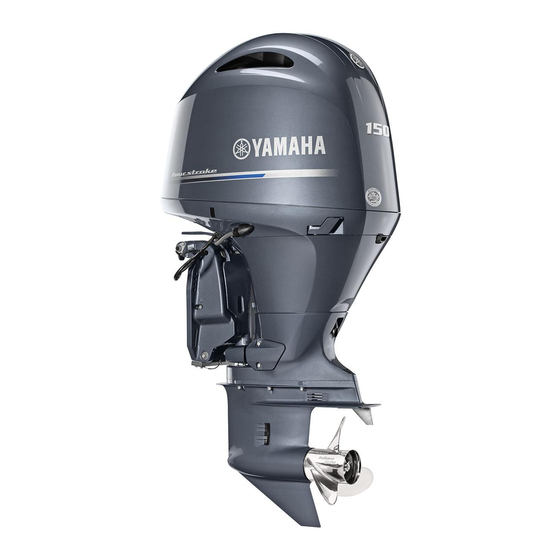
Summarization of Contents
Important Manual Information
Owner Information and Manual Conventions
Explains manual purpose, conventions for warnings, notices, and tips.
Safety Information
Key Safety Precautions
Essential precautions for safe operation, covering propeller, rotating parts, hot parts, electric shock, trim/tilt, and shut-off cord.
Fuel, Environmental, and Operational Safety
Covers gasoline hazards, carbon monoxide, modifications, alcohol/drugs, PFDs, people in water, overloading, and weather.
Collision Avoidance and Regulations
Guidance on avoiding collisions, checking weather, passenger training, and obeying marine laws.
General Information
Identification Numbers and Compliance Labels
Explains serial number, key number, EC Declaration of Conformity, CE Marking, and compliance labels.
Manuals and Warning Labels
Instructions on reading manuals, understanding warning labels, and obtaining replacements.
Specifications and Requirements
Engine and Performance Specifications
Details dimensions, weight, performance, power unit, ignition, fuel, and lower unit specifications.
Installation and Fuel/Oil Requirements
Covers boat horsepower, mounting, remote control, recommended fuel, and oil specifications.
Battery Requirements and Propeller Selection
Details battery specifications, mounting, and guidance on selecting the correct propeller.
Components
Component Identification Diagram
Illustrates and labels key external components of the outboard motor.
Optional Items and Security System
Lists available accessories like remote controls, meters, and the Yamaha Security System.
Remote Control and Lever Operation
Explains operation of remote control levers, throttle friction, and engine shut-off cord.
Instruments and Indicators
Tachometer and Trim Meter
Describes the tachometer for engine speed and trim meter for motor angle.
Speedometer, Fuel Gauge, and Trip Meter
Explains how to read speedometer, fuel gauge, trip meter, clock, and voltmeter functions.
Fuel Management and Multifunction Displays
Details fuel flow, consumption, economy meters, and alert indicators.
Engine Control System
Alert System Overview
Explains the function of alert devices and the overheat alert system.
Low Oil Pressure and Water Separator Alerts
Describes low oil pressure, water separator, and other alerts, guiding user actions.
Installation
Outboard Motor Mounting Procedures
Provides guidance on proper mounting location and height for optimal performance and safety.
Operation
First-Time Operation and Engine Break-In
Covers initial oil fill, engine break-in procedure, and getting acquainted with boat handling.
Fuel System Checks and Leaks
Details checks for fuel level, cowling, fuel leaks, and the fuel filter.
Controls Operation and Engine Warm-up
Explains steering, throttle, engine shut-off, warm-up procedures, and stop switches.
Shifting Procedures and Engine Warm-up Checks
Covers engine warm-up, checking stop switches, and shifting procedures.
Stopping Procedures and Trim Adjustment
Covers stopping the engine, trimming the motor for performance, and adjusting trim angle.
Tilting Procedures for Protection
Explains how to tilt the outboard motor up and down for protection and storage.
Shallow Water and Other Condition Operation
Guidance on operating in shallow water and other conditions like salt or muddy water.
Maintenance
Transporting, Storing, and Flushing
Instructions for safe transport, long-term storage, and flushing the cooling system.
Lubrication and Cooling System Maintenance
Covers gear oil change, greasing, and flushing cooling water passages.
Cleaning and Surface Checks
Instructions for cleaning the motor exterior and checking the painted surface for corrosion.
Maintenance Chart 1 Details
Lists initial and periodic maintenance items, actions, intervals, and corresponding pages.
Maintenance Chart 2 Details
Lists 1000-hour maintenance items, actions, and corresponding pages.
Periodic Maintenance
Maintenance Schedules and Conditions
Outlines regular maintenance tasks, schedules, and procedures for severe operating conditions.
Inspecting Spark Plug
Idle Speed Inspection and Engine Oil Change
Covers checking idle speed and the procedure for changing engine oil.
Engine Oil Change Procedure Details
Detailed steps for changing engine oil, including using an oil changer.
Oil Level Check and Final Steps
Rechecking oil level, starting engine, and disposing of used oil.
Inspecting Wiring and Connectors
Wiring and Connector Inspection
Instructions for inspecting wiring harnesses and connectors for secure connections.
Checking propeller
Propeller Inspection and Removal
Covers checking propeller blades, shaft, splines, and removing the propeller.
Propeller Installation and Gear Oil Change
Covers installing the propeller, torque specifications, and the procedure for changing gear oil.
Gear Oil Change Procedure Details
Detailed steps for changing gear oil, including draining and filling.
Inspecting and Replacing Anode(s)
Anode Inspection and Replacement
Explains how to inspect and replace sacrificial anodes for corrosion protection.
Checking Battery
Battery Charge and Connections
Covers checking battery charge, connections, and safety precautions.
Battery Connection and Disconnection
Provides procedures for connecting and disconnecting the battery, including safety notices.
Trouble Recovery
Troubleshooting Starting Issues
Lists causes and remedies for problems with starting, engine idle, power loss, and vibration.
Troubleshooting Engine Idle and Alerts
Covers issues with engine idle, alert buzzers, indicator lights, and oil-related problems.
Troubleshooting Power Loss and Vibration
Addresses causes for engine power loss, vibration, and propeller damage.
Emergency Actions for Impact and Single Engine Operation
Procedures for handling impact damage and operating with a single engine in emergencies.
Fuse Replacement and Manual Trim/Tilt
Covers replacing fuses and manually operating the power trim and tilt system.
Water Separator Alert Procedure
Steps to address a water separator alert, including draining the fuel filter.
Submerged Motor Handling and Inspection
Procedures to follow if the outboard motor is submerged, emphasizing immediate dealer inspection.
Engine Data Recording
Privacy Policy for Engine Data
Explains how engine data is collected, used, and protected by Yamaha.

















Need help?
Do you have a question about the F150F and is the answer not in the manual?
Questions and answers